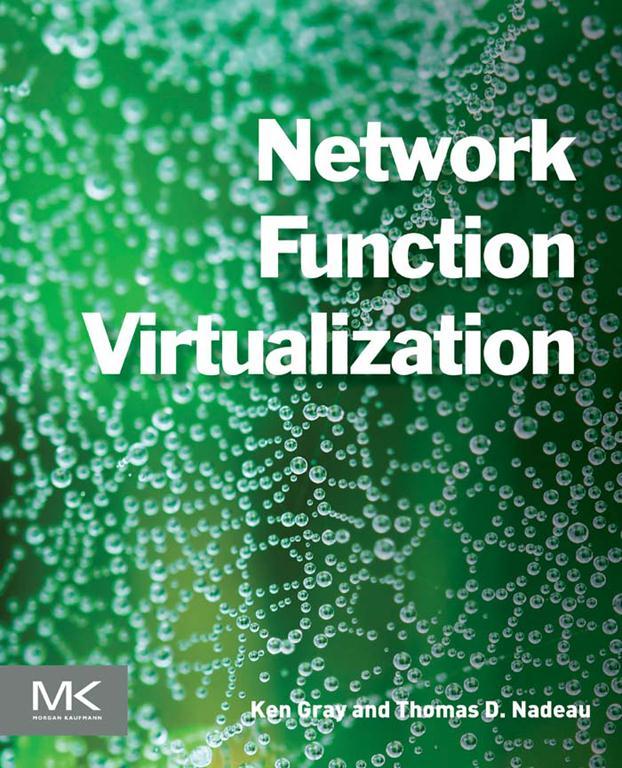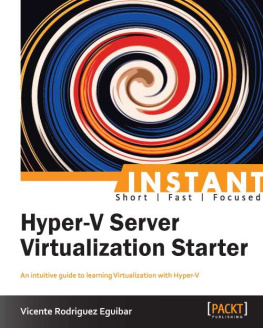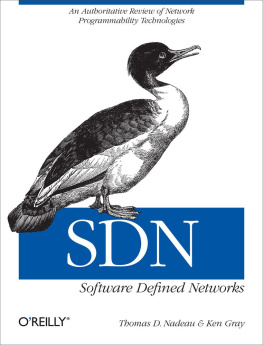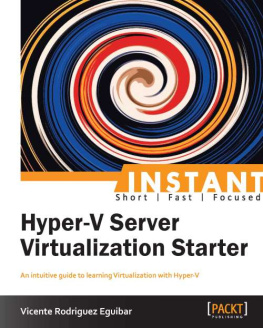Gray Ken - Network Function Virtualization
Here you can read online Gray Ken - Network Function Virtualization full text of the book (entire story) in english for free. Download pdf and epub, get meaning, cover and reviews about this ebook. City: Cambridge (Estados Unidos, year: 2017;2016, publisher: Elsevier Science & Technology;Morgan Kaufmann, genre: Romance novel. Description of the work, (preface) as well as reviews are available. Best literature library LitArk.com created for fans of good reading and offers a wide selection of genres:
Romance novel
Science fiction
Adventure
Detective
Science
History
Home and family
Prose
Art
Politics
Computer
Non-fiction
Religion
Business
Children
Humor
Choose a favorite category and find really read worthwhile books. Enjoy immersion in the world of imagination, feel the emotions of the characters or learn something new for yourself, make an fascinating discovery.

- Book:Network Function Virtualization
- Author:
- Publisher:Elsevier Science & Technology;Morgan Kaufmann
- Genre:
- Year:2017;2016
- City:Cambridge (Estados Unidos
- Rating:4 / 5
- Favourites:Add to favourites
- Your mark:
- 80
- 1
- 2
- 3
- 4
- 5
Network Function Virtualization: summary, description and annotation
We offer to read an annotation, description, summary or preface (depends on what the author of the book "Network Function Virtualization" wrote himself). If you haven't found the necessary information about the book — write in the comments, we will try to find it.
Network Function Virtualization — read online for free the complete book (whole text) full work
Below is the text of the book, divided by pages. System saving the place of the last page read, allows you to conveniently read the book "Network Function Virtualization" online for free, without having to search again every time where you left off. Put a bookmark, and you can go to the page where you finished reading at any time.
Font size:
Interval:
Bookmark:

- Tables in Chapter 7
- Figures in Chapter 1
- Figures in Chapter 2
- Figures in Chapter 3
- Figures in Chapter 4
- Figures in Chapter 5
- Figures in Chapter 6
- Figures in Chapter 7
- Figures in Chapter 8
Ken Gray
Director, CTO and Architecture Group, Cisco Systems
Thomas D. Nadeau
Chief Architect, Open Source and Distinguished Engineer, Brocade Communications Systems

Morgan Kaufmann is an imprint of Elsevier
50 Hampshire Street, 5th Floor, Cambridge, MA 02139, United States
Copyright 2016 Elsevier Inc. All rights reserved.
No part of this publication may be reproduced or transmitted in any form or by any means, electronic or mechanical, including photocopying, recording, or any information storage and retrieval system, without permission in writing from the publisher. Details on how to seek permission, further information about the Publishers permissions policies and our arrangements with organizations such as the Copyright Clearance Center and the Copyright Licensing Agency, can be found at our website: www.elsevier.com/permissions.
This book and the individual contributions contained in it are protected under copyright by the Publisher (other than as may be noted herein).
Notices
Knowledge and best practice in this field are constantly changing. As new research and experience broaden our understanding, changes in research methods, professional practices, or medical treatment may become necessary.
Practitioners and researchers must always rely on their own experience and knowledge in evaluating and using any information, methods, compounds, or experiments described herein. In using such information or methods they should be mindful of their own safety and the safety of others, including parties for whom they have a professional responsibility.
To the fullest extent of the law, neither the Publisher nor the authors, contributors, or editors, assume any liability for any injury and/or damage to persons or property as a matter of products liability, negligence or otherwise, or from any use or operation of any methods, products, instructions, or ideas contained in the material herein.
British Library Cataloguing-in-Publication Data
A catalogue record for this book is available from the British Library
Library of Congress Cataloging-in-Publication Data
A catalog record for this book is available from the Library of Congress
ISBN: 978-0-12-802119-4
For Information on all Morgan Kaufmann publications visit our website at https://www.elsevier.com/

Publisher: Todd Green
Acquisition Editor: Brian Romer
Editorial Project Manager: Amy Invernizzi
Production Project Manager: Priya Kumaraguruparan
Designer: Victoria Pearson
Typeset by MPS Limited, Chennai, India
Dave Ward
Lift and Shift Is Necessary but not Sufficient
This book by Ken and Tom on Network Function Virtualization is perhaps the first time they have laid out both a fantastic review of the vast landscape of technologies related to virtualized networking, and woven in a subtle argument and allusion to what the future of this technology holds. I may be drunk on my own Koolaid, but I certainly read the book with a specific lens in which I asked the question Where are we on the maturity continuum of the technology and how close is it to what operators and customers need or want to deploy? The answer I believe I read from Tom and Ken is that Weve only just begun. (Now try and get Karen Carpenter out of your head while reading the rest of this  ). What I mean by this is that over the last say 6 years of trade-rag-eye-ball-seeking articles, the industry has lived through huge hype cycles and presumptive close arguments of download-install-transition-your-telco/mso to a whole new business.
). What I mean by this is that over the last say 6 years of trade-rag-eye-ball-seeking articles, the industry has lived through huge hype cycles and presumptive close arguments of download-install-transition-your-telco/mso to a whole new business.
What K/T lay out is not only an industry in transition but one that is completely dependent on the pace being set by the integration of huge open source projects and proprietary products, proprietary implementations of newly virtualized appliances, huge holes in the stack of SW required to make the business: resilient, anti-fragile, predictable, supportable, able to migrate across DCs, flexibly rearrangeable, a whole mess of additional x-ilities and most importantly operate-able and billable. This transition MUST happen for the industry and it MUST happen in many networking-dependent industries. Why? Because the dominant architecture of many SPs is one in which flexible data centers were not considered part of the service delivery network. On-demand user choice was not the norm. Therefore, trucking in a bunch of compute-storage-switching (aka data centers) does not by itself deliver a service. SPs build services in which there are SLAs (many by regulation in addition to service guarantees), guarantees of experience, giving access to any and all new devices that arrive on the market and as a goal focus on building more and more uses of their network. The key message this book lays out is that: its complex, there are a ton of moving parts, there are layers upon layers, there are very few peopleif in fact anythat can hold the entire architecture in their head and keep track of it. And most importantly; we are closer to the starting line than the finish line.
Thankfully as K/T have laid out in another book, we have made it through the SDN-hype cycle and its being rolled out across the industry. We watched the movie Rise of the Controllers and the industry is settled down and deploying the technology widely. Now we are to the point where virtualizing everything is the dominant topic. Technology progresses. It requires a lot of stack and all that is necessary in that stack does not exist today and is in various stages of completeness, but not integrated into something consistent or coherent yet. Also, when someone says VNF (virtualized network function) or NFV (network function virtualization): (1) it applies to more than networking related stuff, see video production and playout services and (2) the terms were defined when hypervisors where the only choice for virtualization. Now that containers are available; we have to clearly set the industry goal that cloud native (which is basically a synonym for containerized applications) is the ultimate endpoint; until the next wave comes in. The real point is that lifting and shifting of physical appliances to hypervisor based VNFs (necessary first step but not sufficient) led to one particular stack of technology, but cloud-native leads to a different variant. One in which use of DC resources is dramatically lower, time to boot/active service is faster and parallelism is the central premise. For the love of all the G*ds, I truly hope that the industry does not stall prematurely. Without knowing what Ken and Tom are up to next; its an easy prediction to make that this book will have a potential for 42 versions of publication as today it documents the first steps toward this industry revolution.
Font size:
Interval:
Bookmark:
Similar books «Network Function Virtualization»
Look at similar books to Network Function Virtualization. We have selected literature similar in name and meaning in the hope of providing readers with more options to find new, interesting, not yet read works.
Discussion, reviews of the book Network Function Virtualization and just readers' own opinions. Leave your comments, write what you think about the work, its meaning or the main characters. Specify what exactly you liked and what you didn't like, and why you think so.





